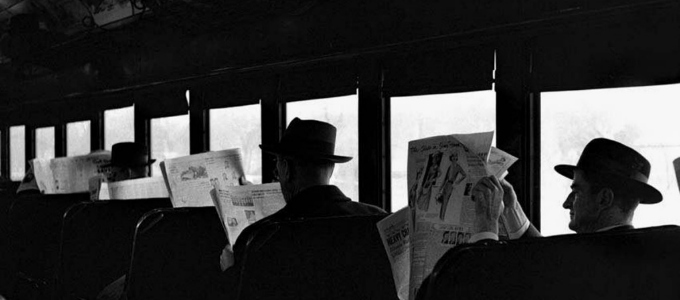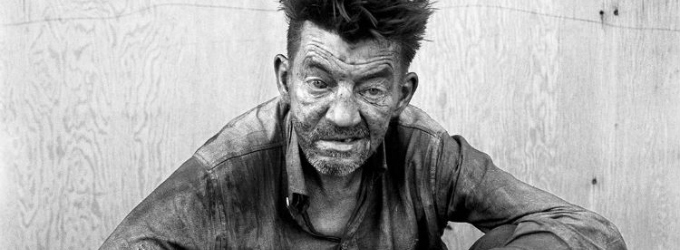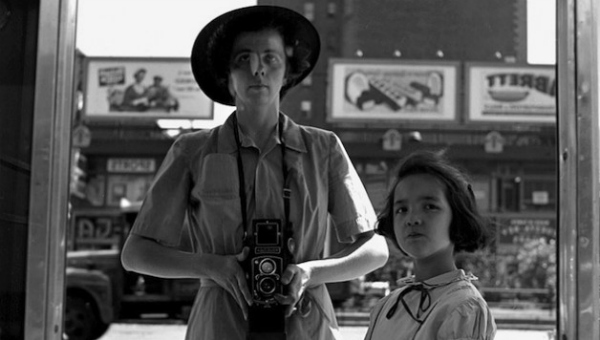
Today we “capture images”, compulsively, profligately, and then we share them on Flickr and Tumblr and Instagram and…Vivian Maier took photographs, compulsively, profligately, and then she—put them in a box. At some point she stopped even developing the film.
Maier could lay bare the contradictions of wealth and privilege as well as Lisette Model could, she could force one to confront and sympathise with the marginal and dispossessed well as Diane Arbus could; and she could snatch from the air a fleeting moment as decisive as any snapped by Cartier-Bresson. But she also created moments, injecting herself into the personal space of strangers. Professional quality street photography can be hard these days because an SLR looks like a weapon, it turns the shooter into a sinister Cyclops. But there is another way, one that lets the photographer meet the eye of the subject. The best portrait photography is done that way, and that’s how Maier shot the streets of Chicago and New York. In addition, through her day-job as a nanny, a child-minder or a house-keeper, she also recorded the domestic, women’s world not often given a thorough treatment by photographers.
Not an easy task, as she seems to have presented a different story of herself to every family she worked for…
John Maloof wasn’t the first to discover Maier’s work, but he was the first to successfully commercialise it. FINDING VIVIAN MAIER tells that story of discovery, interleaved with Maier’s story as told through her pictures, by the children she minded as a nanny and by the parents who employed her. This sort of thing can come spectacularly unglued if the discoverer overwhelms the subject, but Maloof and Siskel manage to maintain a suitable balance. Maloof recapitulates to camera and then catches up with the story of his finding Maier’s work, getting it printed and exhibited, finding the families in the domestic shots, and finding out who Maier was. Not an easy task, as she seems to have presented a different story of herself to every family she worked for – the only constants being an air of French sophistication, intense privacy, a peripatetic pack-rat’s mound of carefully packed-up junk and of course a camera around her neck.
The film is tightly edited, with a few flourishes here and there, and a steady beat of surprises as the next twist in the next layer of the onion of Maier’s life is revealed. Not only did Maier have a different face for each family, she had a different face for the parents and the children in each family. The parents and their kids are interviewed separately and tell very different stories. The parents are often touchingly protective of “Viv” or “Vivian” or “Miss Maier” or whomever it was they thought they employed. The children, not so much.
 Maier appears in many of her street shots, reflected here and there, or as a shadow on the ground, or on the wall. She also shot deliberate self-portraits, often clever and witty. She appears like a person out of time, dressed in the boxy fashions of her parents’ generation. Maloof bought not only her many boxes of negatives but also her many boxes of what, if you were being generous, you’d call “ephemera”. She gathered the minutiae of her world and carried it with her, to excess. From these Maloof constructs a portrait of Maier, presumably the only accurate one, based on the paper trail she left across the world, and kept and hid. But because she kept and hid it, it lays her bare in a way which would probably horrify her. Nevertheless, Maloof plainly has respect, liking and admiration for Maier, who was in her own words a “kind of spy” and in his “a kind of journalist”, as he is a kind of historian.
Maier appears in many of her street shots, reflected here and there, or as a shadow on the ground, or on the wall. She also shot deliberate self-portraits, often clever and witty. She appears like a person out of time, dressed in the boxy fashions of her parents’ generation. Maloof bought not only her many boxes of negatives but also her many boxes of what, if you were being generous, you’d call “ephemera”. She gathered the minutiae of her world and carried it with her, to excess. From these Maloof constructs a portrait of Maier, presumably the only accurate one, based on the paper trail she left across the world, and kept and hid. But because she kept and hid it, it lays her bare in a way which would probably horrify her. Nevertheless, Maloof plainly has respect, liking and admiration for Maier, who was in her own words a “kind of spy” and in his “a kind of journalist”, as he is a kind of historian.
Maloof does seem to have something of an axe to grind regarding what that he calls, too often, the mainstream art establishment. They won’t take Maier’s negatives into their collections and won’t exhibit the prints he’s had struck from them. Maier fits something of the mould of the “outsider artist”, although not nearly so much as the sometimes disingenuous framing narrative of the film would have us think. Maloof is right that some recognised photographers did not do their own printing, but what he exhibits are his prints of his edit of Maier’s work, and one can understand why MoMA wouldn’t be that interested in Maloof’s mashup.
Vivian Maier had an unflinching and unsentimental eye, yet also a compassionate, understanding one…
Although she shot a lot of 35mm stills, and 16mm and 8mm movies, it’s her Medium Format work from the mid twentieth century that really excites. The typical Medium Format shot is something we don’t see much of these days. It’s slightly wide angle but still with shallow depth–of–field, so lots of the business of the world gets included in the shot, but still our eye is drawn to the crisp subject. The negatives are big and rich in detail: even on a “prosumer” flatbed scanner at home, as Maloof used, you can easily get 40 megapixels off them. The point of view is often low, a child’s perspective, and she sometimes roamed the city streets with a child in tow. It’s the waist-level finder on Rolleis and their ilk that both results in that view and allows the photographer to meet the gaze of their subject. Vivian Maier had a good, unflinching and unsentimental eye, yet also a compassionate, understanding one and her subjects seem to have recognised that.
Vivian Maier is gone, and one day Flickr, or Tumblr, or Instagram or whomever will withdraw its service and you’ll find out the difference between a “customer” and a “user” and all your images will be gone, too. And so will Maloof’s film, captured using a DSLR. But, now that they’ve been unearthed, Vivian Maier’s silver shadows will last forever.
httpvh://youtu.be/2o2nBhQ67Zc

